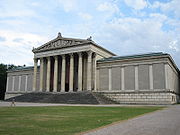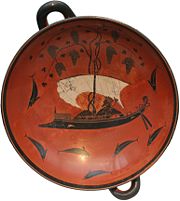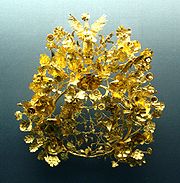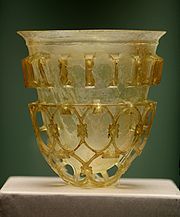
Staatliche Antikensammlungen
Encyclopedia

Kunstareal
The Kunstareal is a museum quarter in the city centre of Munich, Germany.It consists of the three "Pinakotheken" galleries , the Glyptothek, the Staatliche Antikensammlung , the Lenbachhaus, the Museum Brandhorst and...
of Munich
Munich
Munich The city's motto is "" . Before 2006, it was "Weltstadt mit Herz" . Its native name, , is derived from the Old High German Munichen, meaning "by the monks' place". The city's name derives from the monks of the Benedictine order who founded the city; hence the monk depicted on the city's coat...
is a museum for the Bavaria
Bavaria
Bavaria, formally the Free State of Bavaria is a state of Germany, located in the southeast of Germany. With an area of , it is the largest state by area, forming almost 20% of the total land area of Germany...
n state's antique collections for Greek
Greek art
Greek art began in the Cycladic and Minoan prehistorical civilization, and gave birth to Western classical art in the ancient period...
, Etruscan
Etruscan civilization
Etruscan civilization is the modern English name given to a civilization of ancient Italy in the area corresponding roughly to Tuscany. The ancient Romans called its creators the Tusci or Etrusci...
and Roman art
Roman art
Roman art has the visual arts made in Ancient Rome, and in the territories of the Roman Empire. Major forms of Roman art are architecture, painting, sculpture and mosaic work...
. The Bavarian state collection of Ancient Egyptian art
Art of Ancient Egypt
Ancient Egyptian art is the painting, sculpture, architecture and other arts produced by the civilization in the lower Nile Valley from 5000 BC to 300 AD. Ancient Egyptian art reached a high level in painting and sculpture, and was both highly stylized and symbolic...
is traditionally placed in its own museum
Staatliche Sammlung für Ägyptische Kunst
The Staatliches Museum Ägyptischer Kunst in Munich is the Bavarian State Collection for Ancient Egypt art. It displays exhibits from all periods of Ancient Egypt's history. The associated small Middle East section displays objects from the areas of Assyrian and Babylonian culture...
. This museum is also complemented by the sculptures collection, which is located in the opposite Glyptothek
Glyptothek
The Glyptothek is a museum in Munich, Germany, which was commissioned by the Bavarian King Ludwig I to house his collection of Greek and Roman sculptures . It was designed by Leo von Klenze in the Neoclassical style, and built from 1816 to 1830...
.
History of the building
The neo-classicalClassicism
Classicism, in the arts, refers generally to a high regard for classical antiquity, as setting standards for taste which the classicists seek to emulate. The art of classicism typically seeks to be formal and restrained: of the Discobolus Sir Kenneth Clark observed, "if we object to his restraint...
building at Königsplatz
Königsplatz
Königsplatz is a square in Munich, Germany.-Architecture:The square was designed with the creation of the Brienner Straße at the command of Crown Prince Ludwig of Bavaria by Karl von Fischer and laid out by Leo von Klenze....
with Corinthian columns
Corinthian order
The Corinthian order is one of the three principal classical orders of ancient Greek and Roman architecture. The other two are the Doric and Ionic. When classical architecture was revived during the Renaissance, two more orders were added to the canon, the Tuscan order and the Composite order...
was established in 1848 as counterpart to the opposite Glyptothek
Glyptothek
The Glyptothek is a museum in Munich, Germany, which was commissioned by the Bavarian King Ludwig I to house his collection of Greek and Roman sculptures . It was designed by Leo von Klenze in the Neoclassical style, and built from 1816 to 1830...
and commissioned by the Bavarian King Ludwig I
Ludwig I of Bavaria
Ludwig I was a German king of Bavaria from 1825 until the 1848 revolutions in the German states.-Crown prince:...
. The architect was Georg Friedrich Ziebland. Already from 1869 to 1872 the building housed the royal antiquarium before the Munich Secession resided here from 1898 to 1912. From 1919 the building contained the New State Gallery. The museum building was severely damaged by bombing in World War II
World War II
World War II, or the Second World War , was a global conflict lasting from 1939 to 1945, involving most of the world's nations—including all of the great powers—eventually forming two opposing military alliances: the Allies and the Axis...
but was reconstructed and reopened to the public in the late 1960s to display the State Collection of Antiques.
Collections


Wittelsbach
The Wittelsbach family is a European royal family and a German dynasty from Bavaria.Members of the family served as Dukes, Electors and Kings of Bavaria , Counts Palatine of the Rhine , Margraves of Brandenburg , Counts of Holland, Hainaut and Zeeland , Elector-Archbishops of Cologne , Dukes of...
antique collections, especially the collection of attic vases of King Ludwig I.
In 1831 his agent Martin von Wagner acquired pottery from the archeological excavation in Vulci, his agent Friedrich von Thiersch purchased by auction the antiques from the estate of Lucien Bonaparte
Lucien Bonaparte
Lucien Bonaparte, Prince Français, 1st Prince of Canino and Musignano , born Luciano Buonaparte, was the third surviving son of Carlo Buonaparte and his wife Letizia Ramolino....
. The king acquired also antique gold jewellery from the collection of Caroline Murat
Caroline Bonaparte
Maria Annunziata Carolina Murat , better known as Caroline Bonaparte, was the seventh surviving child and third surviving daughter of Carlo Buonaparte and Letizia Ramolino and a younger sister of Napoleon I of France...
, Etruscan bronzes excavated in Perugia
Perugia
Perugia is the capital city of the region of Umbria in central Italy, near the River Tiber, and the capital of the province of Perugia. The city is located about north of Rome. It covers a high hilltop and part of the valleys around the area....
and Greek terra-cottas from South Italy.
After the king's death in 1868 his collection was united with the Wittelsbach antique collection which was founded already by Albert V, Duke of Bavaria
Albert V, Duke of Bavaria
Albert V was Duke of Bavaria from 1550 until his death. He was born in Munich to William IV and Marie Jacobaea of Baden.-Early life:Albert was educated at Ingolstadt under good Catholic teachers...
. Later the museum got extended by purchase and donations. Among these private collections are the donations of Paul Arndt
Paul Arndt
Paul Julius Arndt was a German classical archaeologist who was a native of Dresden.He studied classical art under Johannes Overbeck at the University of Leipzig, and classical archeology with Heinrich Brunn at the University of Munich...
(1908), of James Loeb
James Loeb
James Loeb was a Jewish-German-American banker and philanthropist.He was the second born son of Solomon Loeb and Betty Loeb.James Loeb joined his father at Kuhn, Loeb & Co...
(1933), and of Hans von Schoen (1964). These comprehensive collections specialised in smaller antique objects, glassware, bronzes, terra-cottas, jewelry, gold and silver. During World War II the museum lost especially Etruscan pottery, which was stored in the bombed Neue Pinakothek
Neue Pinakothek
The Neue Pinakothek is an art museum in Munich, Germany. Its focus is European Art of the 18th and 19th century and is one of the most important museums of art of the nineteenth century in the world...
.

Pottery of Ancient Greece
As the result of its relative durability, pottery is a large part of the archaeological record of Ancient Greece, and because there is so much of it it has exerted a disproportionately large influence on our understanding of Greek society...
is outstanding, comparable only with the collections of the Louvre
Louvre
The Musée du Louvre – in English, the Louvre Museum or simply the Louvre – is one of the world's largest museums, the most visited art museum in the world and a historic monument. A central landmark of Paris, it is located on the Right Bank of the Seine in the 1st arrondissement...
and the British Museum
British Museum
The British Museum is a museum of human history and culture in London. Its collections, which number more than seven million objects, are amongst the largest and most comprehensive in the world and originate from all continents, illustrating and documenting the story of human culture from its...
. The Mycenaean
Mycenaean Greece
Mycenaean Greece was a cultural period of Bronze Age Greece taking its name from the archaeological site of Mycenae in northeastern Argolis, in the Peloponnese of southern Greece. Athens, Pylos, Thebes, and Tiryns are also important Mycenaean sites...
pottery is represented as well as the pottery from the geometric, the archaic
Archaic period in Greece
The Archaic period in Greece was a period of ancient Greek history that followed the Greek Dark Ages. This period saw the rise of the polis and the founding of colonies, as well as the first inklings of classical philosophy, theatre in the form of tragedies performed during Dionysia, and written...
, the classical
Classical Greece
Classical Greece was a 200 year period in Greek culture lasting from the 5th through 4th centuries BC. This classical period had a powerful influence on the Roman Empire and greatly influenced the foundation of Western civilizations. Much of modern Western politics, artistic thought, such as...
and the Hellenistic
Hellenistic Greece
In the context of Ancient Greek art, architecture, and culture, Hellenistic Greece corresponds to the period between the death of Alexander the Great in 323 BC and the annexation of the classical Greek heartlands by Rome in 146 BC...
period in Greece. The museum exhibits artworks of the most famous Greek potters and painters like the Amasis Painter
Amasis Painter
The Amasis Painter was an ancient Greek vase painter of the black figure style. He owes his name to the fact that eight of the potter Amasis's manufactured marked work are painted by the same painter, who is therefore called the Amasis painter...
, Exekias
Exekias
Exekias was an ancient Greek vase-painter and potter, who worked between approximately 550 BC - 525 BC at Athens. Most of his vases, however, were exported to other regions of the Mediterranean, such as Etruria, while some of his other works remained in Athens. Exekias worked mainly with a...
, Archikles, Glaukytes, the Penthesilea Painter
Penthesilea Painter
The Penthesilea Painter was a Greek vase painter of the Attic red-figure style. His true name is unknown. His conventional name is derived from his name vase, "bowl 2688" in Munich, the inside of which depicts the slaying of Penthesilea by Achilles...
, the Andokides Painter
Andokides Painter
The Andokides painter was an ancient Athenian vase painter who was active from 530 to approximately 515 BCE. His work is unsigned; he is named after Andokides, the potter for whom he worked. He is believed to be the inventor of the red figure style of vase painting.-Beginnings of his art:The...
, Oltos
Oltos
Oltos was a Late Archaic Greek vase painter, active in Athens. From the time between 525 BC and 500 BC, about 150 works by him are known. Two pieces, a cup in Berlin and a cup in Tarquinia , are signed by him as painter.Oltos is thought to have begun his career in the workshop of the potter...
, Kleophon
Kleophon Painter
The Kleophon Painter is the name given to an anonymous Athenian vase painter in the red figure style who flourished in the mid-to-late 5th century BCE...
, Phintias
Phintias (painter)
Phintias was an ancient Greek vase painter; along with Euphronios and Euthymides, he was one of the most important representatives of the Pioneer Group of Athenian red-figure vase painters. Ten works from the period between 525 and 510 BC bearing his signature survive: seven vase paintings and...
, Euphronios
Euphronios
Euphronios was an ancient Greek vase painter and potter, active in Athens in the late 6th and early 5th centuries BC. As part of the so-called "Pioneer Group,"...
, Euthymides
Euthymides
Euthymides was an ancient Athenian potter and painter of vases, primarily active between 515 and 500 BC. He was a member of the Greek art movement later to be known as "The Pioneers" for their exploration of the new decorative style known as red-figure pottery...
, Epiktetos
Epiktetos
Epiktetos was an Attic vase painter in the early red-figure style. Besides Oltos, he is the most important painter of the Pioneer Group. He was active between 520 and 490 BC...
, the Pan Painter, the Berlin Painter
Berlin Painter
The Berlin Painter is the conventional name given to an Attic Greek vase-painter who is widely regarded as a rival to the Kleophrades Painter, among the most talented vase painters of the early 5th century BCE .The Berlin Painter along with the Kleophrades Painter was educated by a member of the...
, Hieron, Makron
Makron (vase painter)
Makron was an ancient Greek vase painter active in Athens ca. 490-480 BC. Though only one signed example of his work is known to have survived, some 350 vases have been attributed to him by Sir John Beazley, making him one of the best surviving painters of the red-figure period.Makron is strongly...
, Douris
Douris (vase painter)
Douris was an ancient Athenian red-figure vase-painter and potter active ca. 500 to 460 BCE.-Work:He began his career painting for the potters Kleophrades and Euphronios, before beginning a long collaboration with the potter Python. He signed 39 vases as a painter, also one as a potter and...
, the Brygos Painter
Brygos Painter
The Brygos Painter was an ancient Greek Attic red-figure vase painter of the Late Archaic period. Together with Onesimos , Douris and Makron, he is among the most important bowl painters of his time. He was active in the first third of the fifth century BCE, especially in the 480s and 470s...
, the Acheloos Painter
Acheloos Painter
The Acheloos Painter was an ancient Greek vase painter of the black-figure style. He received his name after a representation of the fight of the river god Acheloos and Heracles on Amphora F 1851 in the Berlin Antique collection.-Selected works:*Altenburg, Staatliches Lindenau-Museum*Basel,...
and Lydos
Lydos
Lydos was an Attic vase painter in the black-figure style. Active between '’circa’’ 560 and 530 BC, he was the main representative of the '’’Lydos Group’’’ ....
.
An outstanding example for antique jewellery is the gold funerary garland from Armento
Armento
Armento is a town and comune in the province of Potenza, in the Southern Italian region of Basilicata....
(4th century BC).
A famous Roman goblet from Cologne
Cologne
Cologne is Germany's fourth-largest city , and is the largest city both in the Germany Federal State of North Rhine-Westphalia and within the Rhine-Ruhr Metropolitan Area, one of the major European metropolitan areas with more than ten million inhabitants.Cologne is located on both sides of the...
made of reticella (or network) glass
Cage cup
A cage cup, Greek diatreton, also vas diatretum, plural diatreta, or "reticulated cup" is a type of luxury Late Roman glass vessel, found from roughly the 4th century, and "the pinnacle of Roman achievements in glass-making"...
(4th century AD) still shows its Latin inscription BIBE MULTIS ANNIS (Drink many years yet!). It was a present of the City of Cologne in return for King Ludwig's support for the completion of Cologne Cathedral.
Part of the Staatliche Antikensammlungen is also a comprehensive collection of ca 800 engraved gems donated by Helmut Hansmann (1924-1996).

